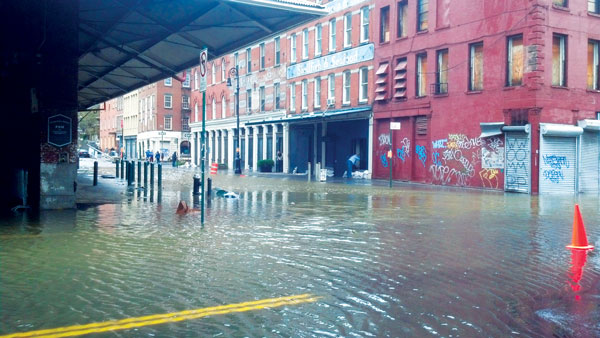
BY ALINE REYNOLDS | Eleven days after Hurricane Sandy deluged Lower Manhattan, scores of South Street Seaport business owners convened at a newly formed task force imploring financial help from any agency that could provide it.
Most of the few-dozen business owners who attended Community Board 1’s Hurricane Sandy Relief Small Business Task Force meeting last week raised their hands when asked how many of their businesses are in the South Street Seaport. And though agency representatives spoke of several disaster recovery loans, the merchants’ resounding request was for grant money, as some of them are still paying back their loans from damages caused by Sept. 11th.
There are a variety of federal, state and city loans available to the small business owners, said the officials. The city Economic Development Corporation (E.D.C.) is offering emergency loans of up to $25,000 per small business with no interest fee for the first six months and a one percent fee per month in the 24 months thereafter, said Alejandro Baquero-Cifuentes, the agency’s vice president of development. There are two other programs — a federal disaster recovery program that offers up to $2 million to fix damages, and a sales tax exemption of up to $100,000 for building materials and equipment.
Some 500 workers have been displaced as a result of Sandy in the South Street Seaport, according to Fernando Dallorso, owner of Stella, one of the severely battered Front Street restaurants. “The faster we get up and running,” he said, “the faster we don’t contribute to the already-high unemployment in this country.”
Dallorso added, “These are not people that have savings. They live day-to-day, mouth-to- mouth.”
Josh Bach, owner of Josh Bach neckwear store near the bottom of Fulton Street, said he is continuing to pay his employees from his wholesale business who have been out of work since the storm. “After I pay them [through the holidays], what am I going to do, fire them and say, ‘I can’t afford you anymore?’” he said.
“There are federal programs as well as state programs to help cover some of those wages so that you’re not faced with laying off employees,” Baquero-Cifuentes told the merchants. Ro Sheffe, who chairs the new C.B. 1 task force, suggested that the owners of the temporarily shuttered businesses apply to the Federal Emergency Management Agency (FEMA) for assistance in recuperating lost wages.
Michael Peacock, a public affairs representative of the U.S. Small Business Administration, talked about federal loans for for-profit businesses and for homeowners, renters and nonprofit organizations. Up to $2 million is available to each of the businesses and organizations, while up to $200,000 will be allocated to eligible homeowners and up to $40,000 to renters. The agency, which currently has centers in Brooklyn and Staten Island, plans to open up offices in Manhattan in the near future to assist applicants in filling out the necessary forms. The process, he said, has been streamlined since the aftermath of 9/11.
The program is particularly beneficial since it doesn’t require collateral, Peacock noted, saying, “We will work with you if you do not have the collateral that’s normally required.”
Incentives must also be created for the chains and other large businesses to stay in the neighborhood, according to Amanda Byron Zink, co-owner of the Salty Paw, at 38 Peck Slip, which will be closed for three to six months. “All of the South Street Seaport chains have closed, boarded up and gone,” she said. “We’ve gotta put pressure on the big guys as well to try to clean up their mess.”
Byron was one of a few small business owners who recently convened at City Hall with Small Business Services director Bernadette Nation. “They had no real information to give us other than that there’s emergency loans available and all sorts of agencies you can reach out to for help,” she said. “My claim is, you need one agency where we can stop in and get all the information. There was so much misinformation going around that we didn’t know our ass from our elbow.”
C.B. 1 member Joel Kopel, who lives in Hanover Square, deemed the discussions with the government officials a déjà-vu of the post-9/11 conversations — prompting cheers from the merchants at the task force meeting. A number of businesses in the vicinity of his apartment building have closed up shop after being flooded by the storm.
“Loans are great, and we appreciate you guys reaching out,” he said, “but if there’s nobody down here to buy your product and your services, you can’t repay the loans back. What we really need to do is get grants. There is going to be a very big reluctance from small business owners who are finally recovering from 9/11…to go into their pocket once again and be on the hook on a personal level.”
Kopel also stressed the importance of getting Verizon’s operations back in service —suggesting that the company install cables above-ground until it is able to fix the below-ground infrastructure. “The only way they’re going to come back to work is by getting these services up and running so people can return to work and get back into the buildings,” he said. “Let them build the beehives and get it restored now instead of waiting for the underground structure to be rebuilt.”
Sheffe noted that Verizon would be reimbursing its Lower Manhattan customers for cell phone charges between Mon., Oct. 29 and Fri., Nov. 16. Jon Bonomo, a spokesperson for Verizon, said that customers whose landline phones are out of service for more than 24 hours are eligible for credit-based reimbursements for the duration of the outages.
One merchant complained that insurance companies are walking away from reimbursement responsibilities under the claim that the South Street Seaport businesses lack flood insurance. In his experience, the companies would only agree to cover damages that are tied to sewage problems. “The initial cause of the flooding is sewer back-up — I even have it on John Street, but they’re going to hide behind the fact that it’s a flood,” he said.
On that note, Kopel — who used to work at William Barthman Jeweler’s Broadway location — advised the business owners to reach out to the state Attorney General’s office for assistance in legal action against the insurance companies. “We did the same thing on 9/11,” he said. “They moved it along, and we got paid.”
Additionally, the merchants bemoaned the lack of storefront and office space available to them during the displacement period. Andrea Katz from WBAI radio, based at 120 Wall St., said her organization has gone on a wild goose chase looking for space to move into. “They’re sending us to real estate agents — we can do that ourselves!” she said. “Where are the grants in terms of rent? Help us out that way. Find us spaces that we can be in rent-free.”
Bach inquired about whether the E.D.C. could temporarily house the businesses in the vacant South Street Seaport properties and waive the leaseholder fees for the struggling businesses.
The Downtown Alliance sent out an e-mail blast to Lower Manhattan property owners recommending that they touch base with the Economic Development Corporation and the Real Estate Board of New York about available storefront space for businesses, according to Stephanie Jennings, the Alliance’s vice president of economic development. However, she said, “We can’t strong-arm properties into making buildings available.”


















